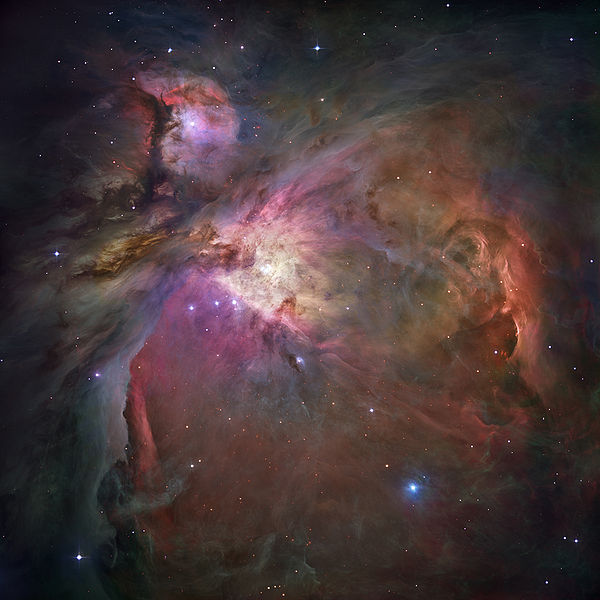|
|
 The Orion Nebula, one of the most famous star-formation regions in the Galaxy. HST image taken from Wikimedia Commons.
The Orion Nebula, one of the most famous star-formation regions in the Galaxy. HST image taken from Wikimedia Commons.
|
Summary of Lecture 6 – Star Birth
- Since bright, massive stars have short lifetimes and yet some still exist, star formation must be a continuing process:
- stars are dense balls of gas;
- interstellar space is filled with gas, most of it very rarefied, but some dense enough to block out light;
- stars form when a clump of this gas collapses under its own gravity.
- The collapse of a cool, dense clump of gas:
- causes its rate of spin to increase (cf. spinning ice skater);
- results in formation of a central spherical protostar surrounded by a spinning disc of gas and dust;.
- heats up the gas, causing it to emit first infra-red and then visible light, and eventually igniting hydrogen fusion in the core of the new star;
- increases pressure, often causing jets of material to be emitted from the poles of the protostar (bipolar outflow).
- We can recognise pre-main-sequence stars:
- they are surrounded by warm gas and dust, which gives off infra-red light (and may block out the visible light from the young star);
- they may have bipolar outflows;
- they are often unstable and hence variable;
- they are larger and cooler than main sequence stars (above and to the right of the main sequence).
So-called T Tauri stars have these properties and are believed to be young Sun-like stars.
- Planetary nebulae and supernova remnants replenish the interstellar gas with material enriched in heavy elements:
- stars forming now are higher in heavy elements than the old stars of the globular clusters;
- very low mass stars, white dwarfs and neutron stars are not recycled, so eventually we will (literally) run out of gas.
- If the collapsing clump is spinning too fast, it may fragment into several gravitationally bound sub-clumps:
- results in binary or multiple systems;
- occurs rather frequently – more than half of all stars near the Sun are members of binary or multiple systems.
- Many young stars are seen to be surrounded by dusty discs:
- as system evolves, dust grains will clump together, eventually forming planets;
- suggests that planetary systems should be common around stars with high heavy element content (dust is made of heavy elements, not hydrogen and helium);
- observed planetary systems do indeed favour stars high in heavy elements.
- If the collapsing clump of gas is very low in mass (<8% of the Sun's mass), hydrogen fusion never starts (the protostar does not get hot enough):
- this is a brown dwarf;
- although they are much more closely related to stars, brown dwarfs may be confused with planets observationally, as the mass ranges may overlap.
Web links
Go back to main page
Go on to Summary for Lecture 7
|
Hicks Building, Hounsfield Road, Sheffield S3 7RH, UK
|